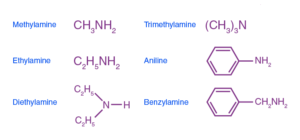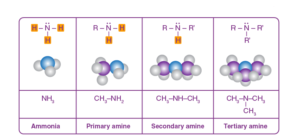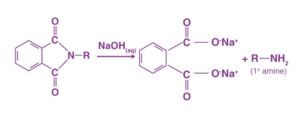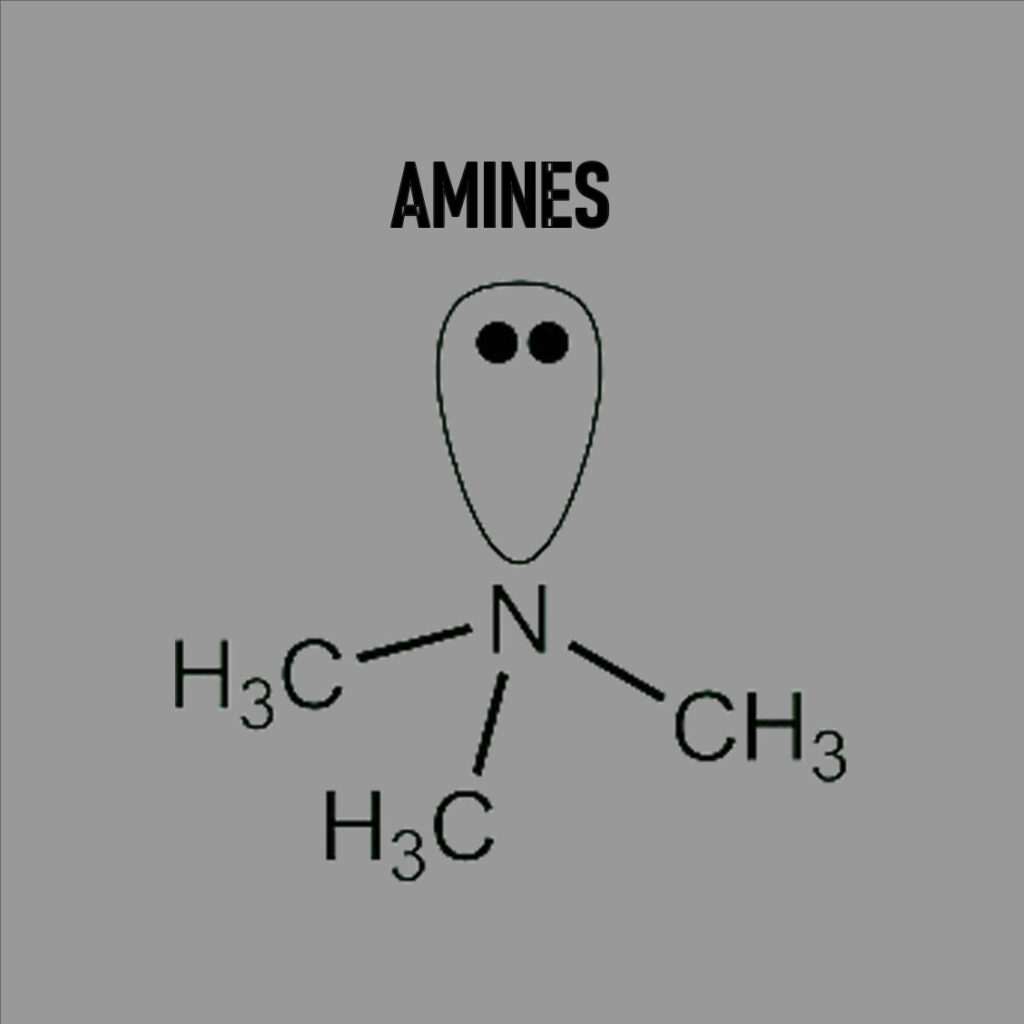Amines
Introduction to Amines – Compounds Containing Nitrogen
Amines represent a crucial class of organic compounds, formed by replacing one or more hydrogen atoms of an ammonia molecule with an alkyl group.
What are Amines?
An amine typically constitutes a functional group featuring a nitrogen atom with a lone pair. Structurally akin to ammonia, amines allow nitrogen to bond with up to three hydrogen atoms. Their properties are also influenced by carbon connectivity.
Compounds wherein nitrogen is connected to a carbonyl group are referred to as amides, bearing the structure R–CO–NR′R″ and exhibiting distinct properties from amines.

Amines are organic compounds characterized by the presence of nitrogen atoms with a lone pair. Essentially, they are derived from ammonia (NH3) wherein one or more hydrogen atoms are substituted by an alkyl or aryl group, consequently termed as alkylamines and arylamines, respectively.
Amine Structure
Nitrogen possesses 5 valence electrons, rendering it trivalent with a lone pair. Following the VSEPR theory, nitrogen in amines adopts an sp3 hybridization state. However, due to the presence of the lone pair, its molecular geometry is pyramidal rather than the typical tetrahedral shape observed in most sp3 hybridized molecules. Each of the three sp3 hybridized orbitals of nitrogen overlaps with orbitals of hydrogen or carbon, depending on the amine’s configuration. The C-N-H angle in amines, owing to the lone pair, is less than the standard 109 degrees characteristic of tetrahedral geometry, typically measuring around 107 degrees.
Occurrence of Amines
Amines occur naturally in proteins, vitamins, hormones, and other biological molecules. Additionally, they are synthetically prepared for the production of polymers, pharmaceuticals, and dyes.
Types of Amines
On the basis of how the hydrogen atoms are replaced by an ammonia molecule, amines can be divided into 4 types.

Here are some examples of different types of amines:
- Primary Amines: When one of the hydrogen atoms of the ammonia molecule is replaced by an alkyl or aryl group.
– Example: Methylamine (CH3NH2), Aniline (C6H5NH2) - Secondary Amines: Two organic substituents replace the hydrogen atoms of the ammonia molecule forming an amine.
– Example: Dimethylamine ((CH3)2NH), Diphenylamine ((C6H5)2NH) - Tertiary Amines: When all three of the hydrogen atoms are replaced by an organic substituent, which could be an aryl or aromatic group.
– Example: Trimethylamine (N(CH3)3), Ethylenediaminetetraacetic acid (EDTA) - Cyclic Amines: These are secondary or tertiary amines in an aromatic ring structure.
– Example: Piperidine ((CH2)5NH), Aziridines (C2H5N)
Preparation of Amines
Some processes for preparing primary amines are mentioned below.
Preparation of Primary Amines
1. Making of amines from halogenoalkanes
The process described will be conducted in a sealed tube. Haloalkanes will be heated with a concentrated solution of ammonia in ethanol. The mixture cannot be heated under reflux because ammonia would escape in the form of gas from the container.

The process described will be conducted in a sealed tube. Haloalkanes will be heated with a concentrated solution of ammonia in ethanol. The mixture cannot be heated under reflux because ammonia would escape in the form of gas from the container.

The above reaction illustrates that a reverse reaction can take place between ammonia and the salt.
2. Reduction of nitriles
Primary amines can be obtained by reducing nitriles with lithium aluminum hydride. This method is primarily utilized for the synthesis of amines with one additional carbon atom compared to the initial amine.

3. Gabriel phthalimide synthesis
Primary amines can be readily obtained through the Gabriel synthesis. In this procedure, treating phthalimide with ethanolic potassium hydroxide yields potassium salts of phthalimide. Upon further heating with alkyl halide followed by alkaline hydrolysis, primary amine is produced. Aromatic primary amines cannot be prepared using this method because aryl halides do not undergo nucleophilic substitution with the anion formed by phthalimide.

Basicity of Amines
Like ammonia, primary and secondary amines exhibit a degree of acidity due to the presence of protic hydrogens. However, tertiary amines lack protic hydrogen and therefore do not exhibit acidity.
The pKa value for primary and secondary amines is approximately 38, indicating their weak acidic nature. On the other hand, their pKb value is about 4, which makes amines more basic than acidic. As a result, an aqueous solution of an amine is strongly alkaline.
Uses of Amines
Here are some examples of the uses of amines in various aspects of our daily lives:
1. Amines find application in water purification, the manufacture of medicines, and the development of insecticides and pesticides.
2. They play a crucial role in the production of amino acids, which serve as the building blocks of proteins in living organisms. Additionally, various types of vitamins are synthesized from amines.
3. Serotonin, an essential amine, serves as a primary neurotransmitter regulating feelings of hunger and influencing the brain’s overall speed of operation.
4. Amines are utilized in the production of pain-relieving medications such as Morphine and Demerol, also known as analgesics.

